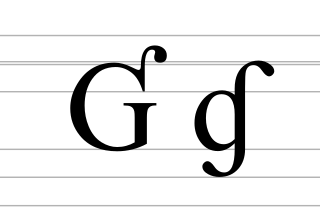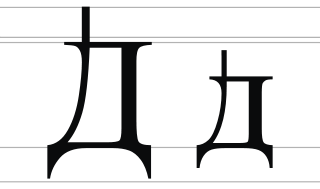
R, or r, is the eighteenth letter of the Latin alphabet, used in the modern English alphabet, the alphabets of other western European languages and others worldwide. Its name in English is ar, plural ars, or in Ireland or.

Ś is a letter of the Latin alphabet, formed from S with the addition of an acute accent. It is used in Polish and Montenegrin alphabets, and in certain other languages or romanizations.

Ɽ, ɽ is a letter of the Latin alphabet, derived from R with the addition of a tail. Its capital form may be based on either the uppercase or lowercase R.

G with hook is a letter of the extended Latin alphabet. In the International Phonetic Alphabet, its small caps form represents the voiced uvular implosive and its lowercase form represents the voiced velar implosive. Because it occurs in the orthographies of some African languages, including some unofficial orthographies of Fula, it is included in the African reference alphabet.

U with bar or barred u is a letter of the Latin alphabet, formed from U with the addition of a bar.

Ṣ is a letter of the Latin alphabet, formed from an S with the addition of a dot below the letter. Its uses include:

Ḍ is a letter of the Latin alphabet, formed from D with the addition of a dot diacritic.

Ƅ is a letter of the Latin alphabet used in the Zhuang alphabet and Bouyei alphabet from 1957 to 1986 to indicate the sixth tone, mid-level. The 'b' shape was chosen for the letter because it resembles the digit '6', and the character represents the sixth tone. In 1986, it was replaced by h.

Che with vertical stroke is a letter of the Cyrillic script. Its form is derived from the Cyrillic letter Che.

Ṛ is a letter of the Latin alphabet, formed from R with the addition of a dot below the letter. It is used in the transliteration of Afro-Asiatic languages to represent an "emphatic r". It is used in transliterating Indo-Aryan and East Iranian languages to represent either syllabic r or a retroflex flap.

Ṭ is a letter of the Latin alphabet, formed from T with the addition of a dot below the letter.

Ẓ is a letter of the Latin alphabet, formed from Z with the addition of a dot below the letter. It is used in the transcription of Afroasiatic languages, specifically:

Ṅ is a letter of the Latin and Sanskrit alphabet, formed by N with the addition of a dot above.

Komi De is a letter of the Molodtsov alphabet, a version of Cyrillic. It was used only in the writing of the Komi language in the 1920s.

Komi Dje is a letter of the Molodtsov alphabet, a variant of Cyrillic. It was used only in the writing of the Komi language in the 1920s.

Komi Dzje is a letter of the Molodtsov alphabet, a variant of Cyrillic used in the writing of the Komi language in the 1920s. It is derived from the Cyrillic letter З.

Komi Lje is a letter of the Molodtsov alphabet, a variant of Cyrillic. It was used only in the writing of the Komi language. It is equivalent to the Cyrillic letter Lje (Љ љ). Some of its forms are similar to the Chinese character 几.

Komi Sje is a letter of the Molodtsov alphabet, a version of the Cyrillic alphabet that was used to write the Komi language in the 1920s. It represented the voiceless alveolo-palatal sibilant, somewhat like the pronunciation of ⟨sh⟩ in "shoe".

Dwe is a letter of the Cyrillic script. The Cyrillic letter has a protruding vertical stroke, as with the Cyrillic Ghe with upturn, in the upper left corner of the Cyrillic De.

Not to be confused with the Voiced glottal fricative. Hwe is a letter of the Cyrillic script. Its form was derived from the Cyrillic letter Shha by adding a hook to the top of the left leg.




















